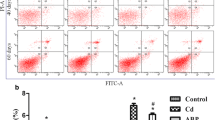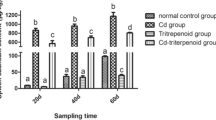Abstract
Cadmium (Cd) can cause animal organism damage, but there have been few studies on the damage of cadmium to the immune organs of birds. Most fungal polysaccharide has antioxidant and immunomodulatory effects. The experimental study investigated the effects of fungal polysaccharide (Agaricus blazei Murill polysaccharide and Ganoderma luciduccharide) on the oxidative damage of central immune organs (thymus and bursa of Fabricius) and on the Toll-like receptor 4 (TLR4) pathway in cadmium-poisoned chickens. The results showed that Agaricus blazei polysaccharide and Ganoderma lucidum polysaccharide can reduce cadmium content, TLR4 expression, inflammatory factor (IL-1β, IL-6, TNF-α) content, and lipid peroxidation product MDA content and increase the activity of antioxidant enzymes SOD and GSH-Px in thymus and bursa of cadmium poisoning chickens. Ganoderma lucidum polysaccharide could decrease the expression of TLR4, IL-1β, and IL-6 in cadmium poisoning peripheral blood lymphocytes of chicken, and TLR4 inhibitor had the same effect. The results demonstrated the protective effects of Agaricus blazei Murill polysaccharide and Ganoderma lucidum polysaccharides on the damage of the central immune organs of chickens caused by cadmium poisoning were closely related to the TLR4 signaling pathway and oxidative stress.






Similar content being viewed by others
References
Burger J (2008) Assessment and management of risk to wildlife from cadmium. Sci Total Environ 389(1):37–45
Patar A, Giri A, Boro F, Bhuyan K, Singha U, Giri S (2016) Cadmium pollution and amphibians - studies in tadpoles of Rana limnocharis. Chemosphere 144:1043–1049
Huo J, Dong A, Yan J, Wang L, Ma C, Lee S (2017) Cadmium toxicokinetics in the freshwater turtle, Chinemys reevesii. Chemosphere 182:392–398
Brzóska MM, Majewska K, Moniuszkojakoniuk J (2004) Mineral status and mechanical properties of lumbar spine of female rats chronically exposed to various levels of cadmium. Bone 34(3):517–526
Marth E, Barth S, Jelovcan S (2000) Influence of cadmium on the immune system. Description of stimulating reactions. Cent Eur J Public Health 8(1):40–44
Calabrese V, Cighetti R, Peri F (2015) Molecular simplification of lipid a structure: TLR4-modulating cationic and anionic amphiphiles. Mol Immunol 63(2):153–161
Pascuallucas M, Fernandezlizarbe S, Montesinos J, Guerri C (2014) LPS or ethanol triggers clathrin- and rafts/caveolae-dependent endocytosis of TLR4 in cortical astrocytes. J Neurochem 129(3):448–462
Oblak A, Pohar J, Jerala R (2015) MD-2 determinants of nickel and cobalt-mediated activation of human TLR4. 10(3):e0120583
Song SY, Bae CH, Choi YS, Kim YD (2016) Cadmium induces mucin 8 expression via Toll-like receptor 4-mediated extracellular signal related kinase 1/2 and p38 mitogen-activated protein kinase in human airway epithelial cells. Int Forum Allergy Rhinol 6(6):638–645
Oshiman K, Fujimiya Y, Ebina T, Suzuki I, Noji M (2002) Orally administered beta-1,6-D-polyglucose extracted from Agaricus blazei results in tumor regression in tumor-bearing mice. Planta Med 68(07):610–614
Liu Z, Ma X, Deng B, Huang Y, Bo R, Gao Z, Yu Y, Hu Y, Liu J, Wu Y (2015) Development of liposomal Ganoderma lucidum polysaccharide: formulation optimization and evaluation of its immunological activity. Carbohydr Polym 117:510–517
Shi M, Zhang Z, Yang Y (2013) Antioxidant and immunoregulatory activity of Ganoderma lucidum polysaccharide (GLP). Carbohydr Polym 95(1):200–206
Song Y, Zhang R, Wang H, Yan Y, Ming G (2017) Protective effect of Agaricus blazei polysaccharide against cadmium-induced damage on the testis of chicken. Biol Trace Elem Res:1–10
Hu X, Zhang R, Xie Y, Wang H, Ge M (2016) The protective effects of polysaccharides from Agaricus blazei Murill against cadmium-induced oxidant stress and inflammatory damage in chicken livers. Biol Trace Elem Res 178(1):1–10
Daley T, Omoregie SN, Wright V, Omoruyi FO (2013) Effects of phytic acid and exercise on some serum analytes in rats orally exposed to diets supplemented with cadmium. Biol Trace Elem Res 151(3):400–405
Satarug S, Garrett SH, Sens MA, Sens DA (2011) Cadmium, environmental exposure, and health outcomes. Environ Health Perspect 16(5):182–190
Xie W, Lv A, Li R, Tang Z, Ma D, Huang X, Zhang R, Ge M (2017) Agaricus blazei Murill polysaccharides protect against cadmium-induced oxidative stress and inflammatory damage in chicken spleens. Biol Trace Elem Res (1):1–12
Zhang R, Yu Q, Shi G, Rui L, Zhang W, Xia Z, Li G, Ming G (2017) chTLR4 pathway activation by Astragalus polysaccharide in bursa of Fabricius. BMC Vet Res 13(1):119
Shagirtha K, ., Muthumani M, ., S M Prabu (2011) Melatonin abrogates cadmium induced oxidative stress related neurotoxicity in rats. Eur Rev Med Pharmacol Sci 15 (9):1039, 1050
Zhao P, Guo Y, Zhang W, Chai H, Xing H, Xing M (2017) Neurotoxicity induced by arsenic in Gallus Gallus: regulation of oxidative stress and heat shock protein response. Chemosphere 166:238–245
Jia S, Li F, Liu Y, Ren H, Gong G, Wang Y, Wu S (2013) Effects of extraction methods on the antioxidant activities of polysaccharides from Agaricus blazei Murrill. Int J Biol Macromol 62(11):66–69
Pan K, Jiang Q, Liu G, Miao X, Zhong D (2013) Optimization extraction of Ganoderma lucidum polysaccharides and its immunity and antioxidant activities. Int J Biol Macromol 55(2):301–306
Acknowledgements
We thank the members of the Traditional Chinese Veterinary Medicine Laboratory at the College of Veterinary Medicine, Northeast Agricultural University.
Funding
This work was supported by the National Science Foundation of China (Grant No. 31272533).
Author information
Authors and Affiliations
Corresponding authors
Ethics declarations
Ethical treatment of animals used in this study was approved by the Animal Welfare Committee protocol (#NEAU-2013-02-0252-11) at Northeast Agricultural University (Harbin, China).
Conflict of Interest
The authors declare that they have no conflict of interest.
Disclaimer
All authors have read the manuscript and agreed to submit it in its current form for consideration for publication in the journal.
Additional information
Publisher’s Note
Springer Nature remains neutral with regard to jurisdictional claims in published maps and institutional affiliations.
Rights and permissions
About this article
Cite this article
Li, R., Zhang, L., Tang, Z. et al. Effects of Fungal Polysaccharide on Oxidative Damage and TLR4 Pathway to the Central Immune Organs in Cadmium Intoxication in Chickens. Biol Trace Elem Res 191, 464–473 (2019). https://doi.org/10.1007/s12011-018-1627-0
Received:
Accepted:
Published:
Issue Date:
DOI: https://doi.org/10.1007/s12011-018-1627-0




